For your best Spring Equinox feast, you'll want to plan around peak sunlight hours between 10 AM and 2 PM if you're using solar cooking methods. Start with seasonal ingredients like fresh arugula, asparagus, and spring onions, then incorporate traditional equinox foods like eggs and sweet sticky rice. You can create balanced meals that honor the day-night equilibrium by mixing light spring greens with heartier root vegetables. Try solar preservation techniques for any leftovers, like making fruit leather or drying fresh herbs. There's a whole world of equinox cooking traditions waiting to inspire your next seasonal celebration.
Understanding the Spring Equinox Balance
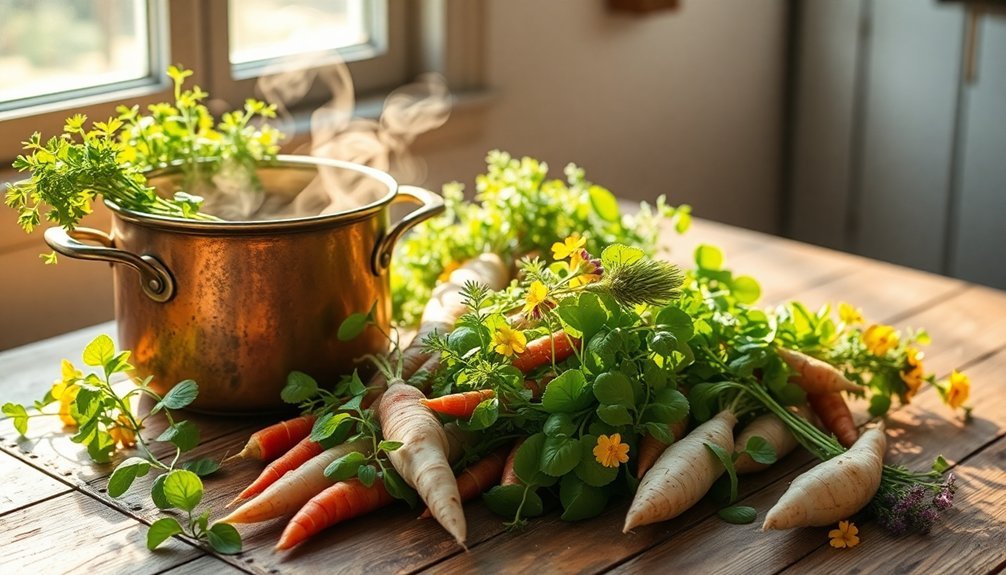
While many people associate the spring equinox with egg-balancing myths, this astronomical event actually marks a remarkable moment of natural equilibrium. During this time, usually around March 20-21, Earth's equator aligns perfectly with the sun's center, creating equal day and night lengths worldwide.
You'll find this period offers a unique opportunity to connect with nature's rhythms as the Northern Hemisphere shifts from winter to spring. This special energy lasts three to four days and provides an extraordinary window for transformation.
It's when you can experience a rare stillness in Earth's energy, making it ideal for reflection and mindful practices. The equinox represents more than just a seasonal shift – it's a cosmic balance point where time seems to pause briefly before tilting toward longer days.
You're witnessing a natural phenomenon that cultures worldwide have celebrated as a symbol of harmony between light and darkness.
Traditional Equinox Foods Across Cultures
As cultures worldwide welcome the changing seasons, traditional equinox foods tell a story of both celebration and survival.
From Bosnia's giant communal scrambled eggs to Thailand's sweet sticky rice with mango, each dish carries deep cultural significance.
You'll find these essential equinox traditions across the globe:
- China's practice of balancing eggs and sipping fresh spring tea
- Mexico's feast of corn, squash, and mangos near the Teotihuacán Pyramid
- Britain's customary pancakes during the spring shift
- Bosnia's Cimburijada festival centered around eggs
Whether you're foraging for wild garlic in early spring or preparing autumn's warm comfort foods, you're participating in age-old customs.
These seasonal ingredients reflect both practicality and symbolism – from fertility-representing eggs to preserved foods that sustain communities through winter.
The ancient practice of feasting before winter helped northern communities prevent food waste and prepare for the cold months ahead.
Planning Your Solar Cooking Schedule
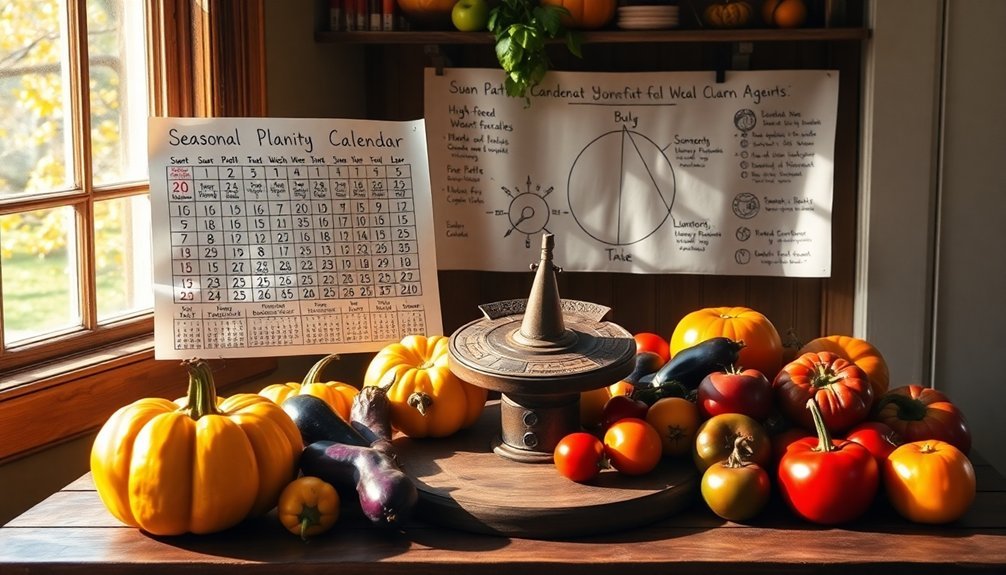
Because solar cooking relies entirely on natural sunlight, creating a well-planned schedule becomes essential for successful outdoor meal preparation.
You'll need to check weather forecasts and plan your cooking between 10:00 a.m. and 2:00 p.m. when sunlight is strongest.
Start by prioritizing dishes based on their cooking times, as solar cooking typically takes 1½ to 3 times longer than conventional methods.
Use black cooking pots to maximize heat absorption, and position your cooker to capture ideal sunlight.
You'll want to monitor temperatures and adjust reflectors throughout the cooking process. The reflective surfaces help concentrate and direct sunlight onto your cooking vessel for maximum efficiency.
Consider factors like food thickness, pot material, and water content when planning your timeline.
Remember to account for setup time and potential weather changes that might affect your cooking schedule.
Keep detailed records to improve your timing for future meals.
Essential Spring Ingredients
You'll find early spring produce bursting with vibrant colors and fresh flavors, from tender arugula and spinach to crisp asparagus and sweet strawberries.
Nature's spring bounty also includes foraged treasures like wild mushrooms and edible flowers, which can elevate your dishes with unique textures and tastes.
These seasonal ingredients pack powerful nutritional benefits, offering natural ways to boost your health as you shift from winter to warmer days.
Vibrant Early Spring Produce
When winter's chill begins to fade, early spring brings an abundance of fresh, vibrant produce to markets and gardens.
You'll find tender leafy greens like arugula and spinach emerging alongside crisp root vegetables and delicate herbs.
Early spring vegetables offer incredible versatility in your kitchen, from raw preparations to quick sautés.
Don't miss these seasonal highlights:
- Fresh herbs and leafy greens: basil, chives, kale, and lettuce
- Tender spring vegetables: asparagus, peas, and artichokes
- Root vegetables: new potatoes, radishes, and spring onions
- Wild and foraged finds: ramps and fava beans
Make the most of spring's bounty by incorporating these ingredients into your meals while they're at their peak freshness and flavor.
They'll transform your cooking with their bright, clean tastes and tender textures.
Foraged Foods For Health
Spring's wild bounty offers more than just fresh flavors – it provides a powerful boost to your health and well-being. When you forage for seasonal ingredients like fresh nettle tips and wild greens, you're accessing nutrients that far exceed those found in cultivated produce. These wild foods pack higher concentrations of vitamins, minerals, and unique phytonutrients that help protect against disease.
You'll notice immediate benefits when incorporating foraged foods into your meals. Studies show they can improve your gut health, stabilize blood sugar levels, and increase energy. They're also completely free of synthetic chemicals and pesticides.
Start by learning to identify spring's edible offerings with professional guidance. You can freeze excess harvest for later use and experiment with creative preparations – try turning foraged acorns into nutritious cookies or crackers for a unique twist on seasonal eating.
Solar Oven Temperature Management
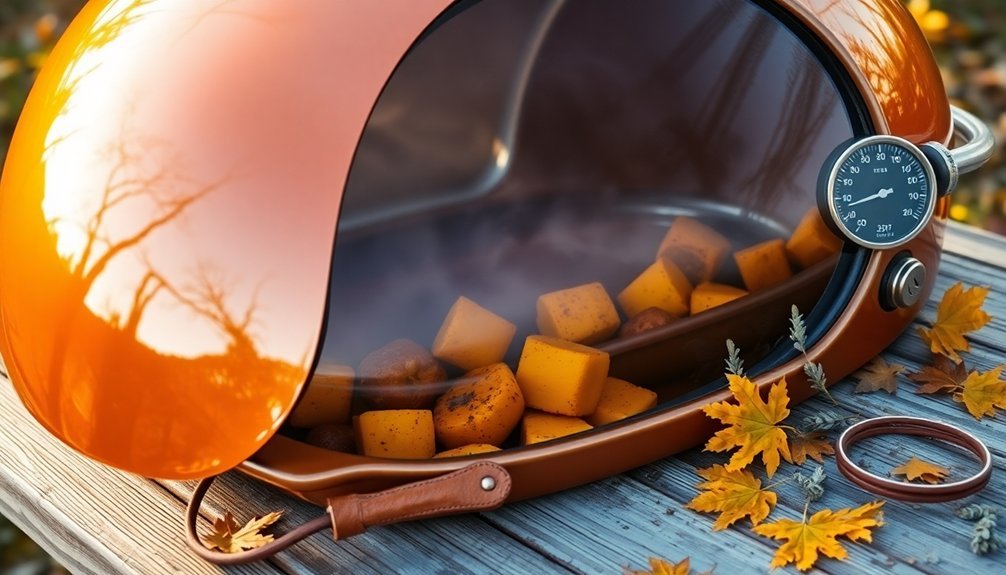
Managing temperature in a solar oven requires careful attention to positioning, insulation, and monitoring techniques. You'll need to face your oven directly toward the sun and adjust its position every 30-45 minutes to maintain ideal heat collection.
Here's what you'll need to master temperature control:
- Use a reliable thermometer to monitor temperatures between 150-225°F
- Preheat your oven for 20-30 minutes before cooking
- Layer insulating materials like crumpled newspaper or dry leaves
- Position dark-colored, lidded cookware in the center
You can fine-tune the temperature by adjusting the reflective flap's angle with a ruler.
For consistent results, cook during peak sun hours (11:00 am to 3:00 pm) and choose a spot sheltered from wind interference. If temperatures climb too high, simply turn the oven slightly away from direct sunlight.
Main Course Solar Cooking Methods
Successful main course preparation in a solar oven depends on matching your cooking method to the available sunlight and type of cooker. You'll get the best results between 11:00 am and 3:00 pm when the sun's position is ideal for maintaining consistent temperatures.
| Cooking Method | Best Hours | Solar Cooker Type |
|---|---|---|
| High-Heat Grilling | 11:00-2:00 | Parabolic |
| One-Pot Meals | 11:00-3:00 | Box Oven |
| Slow-Cooking Stews | 10:00-4:00 | Panel Cooker |
| Pasta & Casseroles | 11:00-3:00 | Box Oven |
For hearty main courses like lasagna or stews, you'll want to start early and use a box oven or panel cooker. If you're sautéing or grilling, choose a parabolic cooker during peak sun hours. Remember to track the sun's movement, especially during shorter winter days, to maintain proper cooking temperatures.
Fresh Spring Salad Combinations
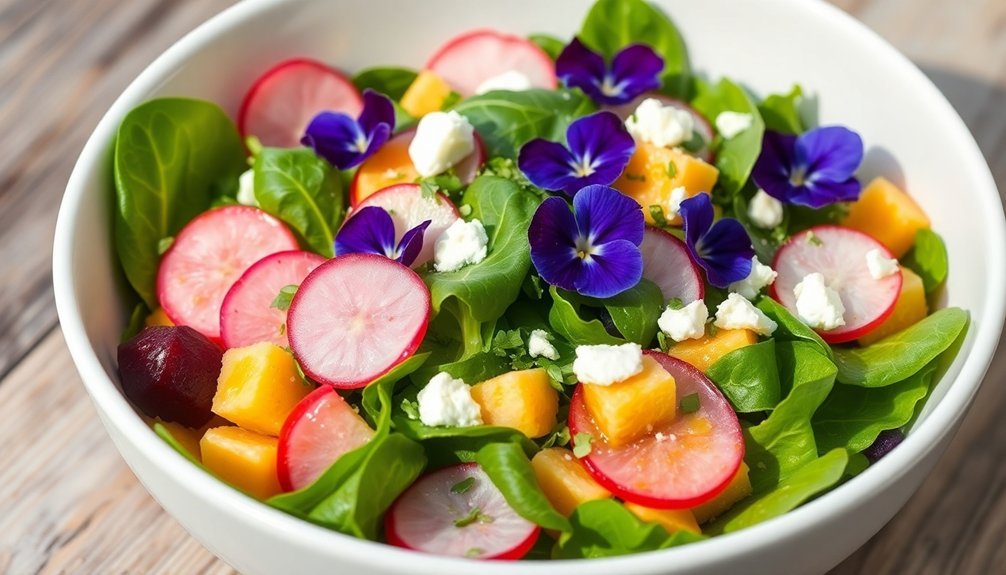
When fresh produce bursts into season, light and vibrant spring salads offer endless combinations of crisp vegetables, tender greens, and bright herbs.
You'll find that mixing blanched asparagus, sweet peas, and peppery radishes with creamy avocado creates a perfect balance of textures and flavors.
- Start with a base of butter lettuce or spring mix, then layer in cucumber slices and halved cherry tomatoes.
- Add protein with crumbled feta or goat cheese, hard-boiled eggs, or roasted chickpeas.
- Incorporate crunch with toasted pistachios, sunflower seeds, or pine nuts.
- Dress your creation with a light vinaigrette using lemon juice, olive oil, and Dijon mustard.
Don't forget to finish with fresh herbs like basil, mint, or dill for an extra burst of seasonal flavor.
Desserts for Solar Baking
From light spring salads, let's turn to a sustainable way of creating sweet treats using nature's own heat source.
You'll find that solar ovens, whether store-bought or DIY versions made from pizza boxes, offer an eco-friendly baking method perfect for spring desserts.
For a delightful solar-baked cheesecake, start by preheating your solar oven while you prepare a vanilla wafer crust.
Beat cream cheese, eggs, sugar, and vanilla until fluffy, then pour into your lined baking tin.
Position your oven to catch maximum sunlight, and you'll need about 2-2.5 hours of baking time.
Don't forget to monitor the temperature – proper insulation and reflection are key.
Once cooled, garnish with fresh fruit for a stunning presentation that's perfect for your equinox gathering.
Timing Your Equinox Feast

Planning your equinox feast requires careful attention to both timing and seasonal availability. Whether you're celebrating spring or autumn, you'll want to align your menu with nature's current offerings at local farmers' markets.
Four key timing considerations for your equinox feast:
- Schedule your shopping 2-3 days before to guarantee the freshest ingredients.
- Plan your prep time around seasonal ingredients that spoil quickly (like spring greens or autumn berries).
- Consider the cooking times of different dishes – roasts and stews need longer than fresh salads.
- Time your feast to coincide with sunset or sunrise for traditional observance.
For spring, focus on early greens and citrus flavors. During autumn, embrace root vegetables and harvest fruits.
Don't forget to adjust your timing based on whether you're hosting a formal dinner or a casual gathering.
Preserving Solar Cooked Spring Bounty
You'll find spring's abundance of fruits and herbs perfectly suited for solar preservation techniques, with fruit leather requiring just pureed fresh fruit spread thinly on dehydrator sheets during peak sunlight hours.
Your homegrown or foraged herbs can be dried quickly on ventilated racks in direct sun between 11 AM and 3 PM when solar intensity reaches its maximum.
To achieve ideal results for both fruit leather and herbs, make certain you're working with bright sunshine, low humidity, and steady airflow while keeping your drying racks away from dust and pollution.
Solar Fruit Leather Methods
While traditional food dehydration often relies on electricity, solar fruit leather offers an eco-friendly alternative that harnesses natural sunlight to transform spring fruits into delicious, shelf-stable treats.
You'll want to select ripe fruits, remove seeds, and blend them with optional cane sugar until smooth. For ideal results, spread your fruit mixture thinly on parchment paper or silicone sheets.
- Keep temperatures above 85°F and humidity below 60%
- Expect 4-7 hours of drying time in consistent sunlight
- Test readiness by touching – it shouldn't crease
- Store in cool conditions between 50-60°F
Your finished fruit leather will stay fresh for 6-12 months when stored properly, or up to two years if frozen.
This method not only preserves nutrients but also reduces food waste while saving energy costs.
Drying Herbs Sun-Style
Fresh herbs deserve the same eco-conscious preservation approach as fruit leather, and solar drying offers a perfect solution. For ideal results, you'll need a warm, dry location with temperatures around 100°F and humidity below 60%. While you can use drying screens under a car windshield, a DIY solar dryer with stackable screens provides better control.
| Equipment | Conditions | Tips |
|---|---|---|
| Drying screens | 100°F temp | Harvest after dew |
| Cheesecloth | 60% humidity | Avoid bruising |
| Glass top | Indirect sun | Single layer only |
Start by harvesting herbs in the morning after the dew evaporates. Rinse them in cool water, shake off excess moisture, and remove any imperfect leaves. Place them in a single layer on screens covered with cheesecloth for better air circulation. Remember to bring your herbs inside at night to protect them from moisture.
Frequently Asked Questions
Can I Substitute Foraged Mushrooms With Store-Bought Varieties in Equinox Recipes?
You can substitute store-bought mushrooms for foraged ones in your recipes. Look for varieties like portobellos and shiitake that mimic earthy flavors. Just adjust seasoning to enhance taste and maintain texture profiles.
How Do Weather Conditions Affect the Flavor of Solar-Cooked Spring Dishes?
You'll find that clear, sunny days create more intense flavors through even cooking, while windy conditions can lead to uneven results. Cloud cover might extend cooking times but won't substantially affect your dish's taste.
Which Edible Flowers Are Safe to Serve to Children?
You can safely serve children lavender, marigolds, nasturtiums, fuchsia, and rose petals from your own garden. Make sure they're thoroughly washed and you've verified they're edible before letting kids eat them.
What Traditional Spring Equinox Herbs Help With Digestion?
You'll find dandelion root, yellowdock, and nettle are powerful digestive aids. Peppermint and wintergreen can ease bloating, while mustards wake up your digestion. These traditional herbs work best during spring's renewal period.
Does the Moon Phase Affect the Cooking Time of Equinox Dishes?
Yes, moon phases can affect your cooking times. During a waxing moon, you'll notice foods often cook faster, while waning moon periods might require longer cooking times for best results in your dishes.
In Summary
You'll find that planning your equinox feast around solar cooking creates a meaningful connection to the season's natural rhythms. Whether you're baking spring vegetables or crafting fresh salads, timing your meal with the sun's position makes the experience more special. Remember to preserve your solar-cooked bounty – it's a great way to extend spring's flavors well beyond the equinox celebration.

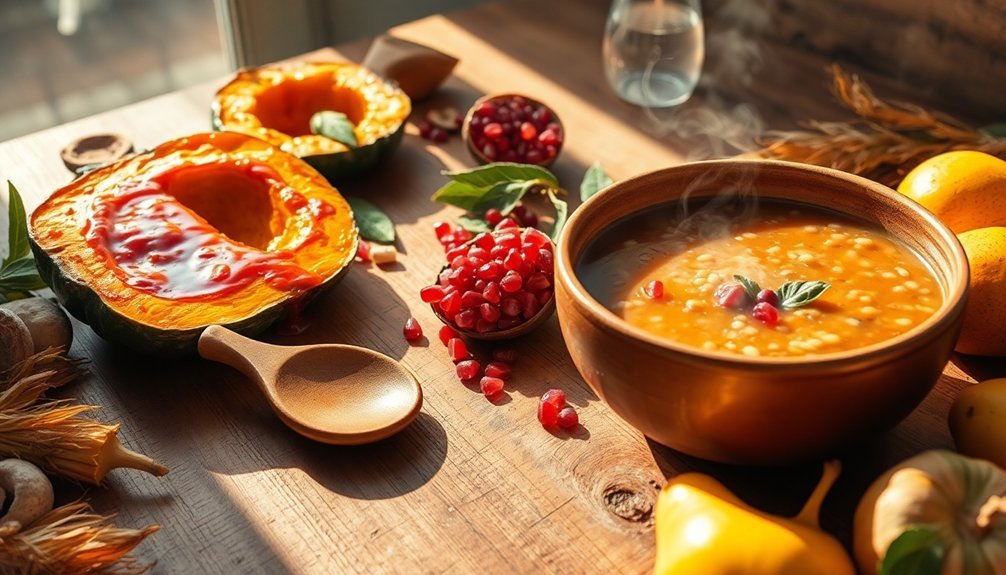



Leave a Reply